Health and Social Care: Life Course Perspective on Midlife Changes
VerifiedAdded on 2020/05/28
|11
|3380
|293
Essay
AI Summary
This essay provides a critical discussion and analysis of the cognitive, psychological, and physical changes that occur during midlife, framed within a life course perspective. It examines the sociological analysis of the life course, emphasizing aging and exploring research on health, well-being, and development from adulthood to old age. The paper delves into the distinct stages of the human life course, focusing on midlife (40-65 years) as a crucial phase marked by various challenges and transitions. It discusses key theories, including those of Jung and Erikson, and models such as the Selective Optimization with Compensation Model, to understand the complexities of midlife. The essay also covers changes in cognitive functioning, personality, self-realization, emotional regulation, and social roles, including family and work dynamics. It also addresses the impact of retirement and physical health considerations during this period. The essay utilizes recent research to explore how individuals navigate these changes, providing insights into the factors influencing well-being and adaptive strategies for coping with the challenges of midlife. The essay is available on Desklib, a platform providing AI-based study tools and resources.
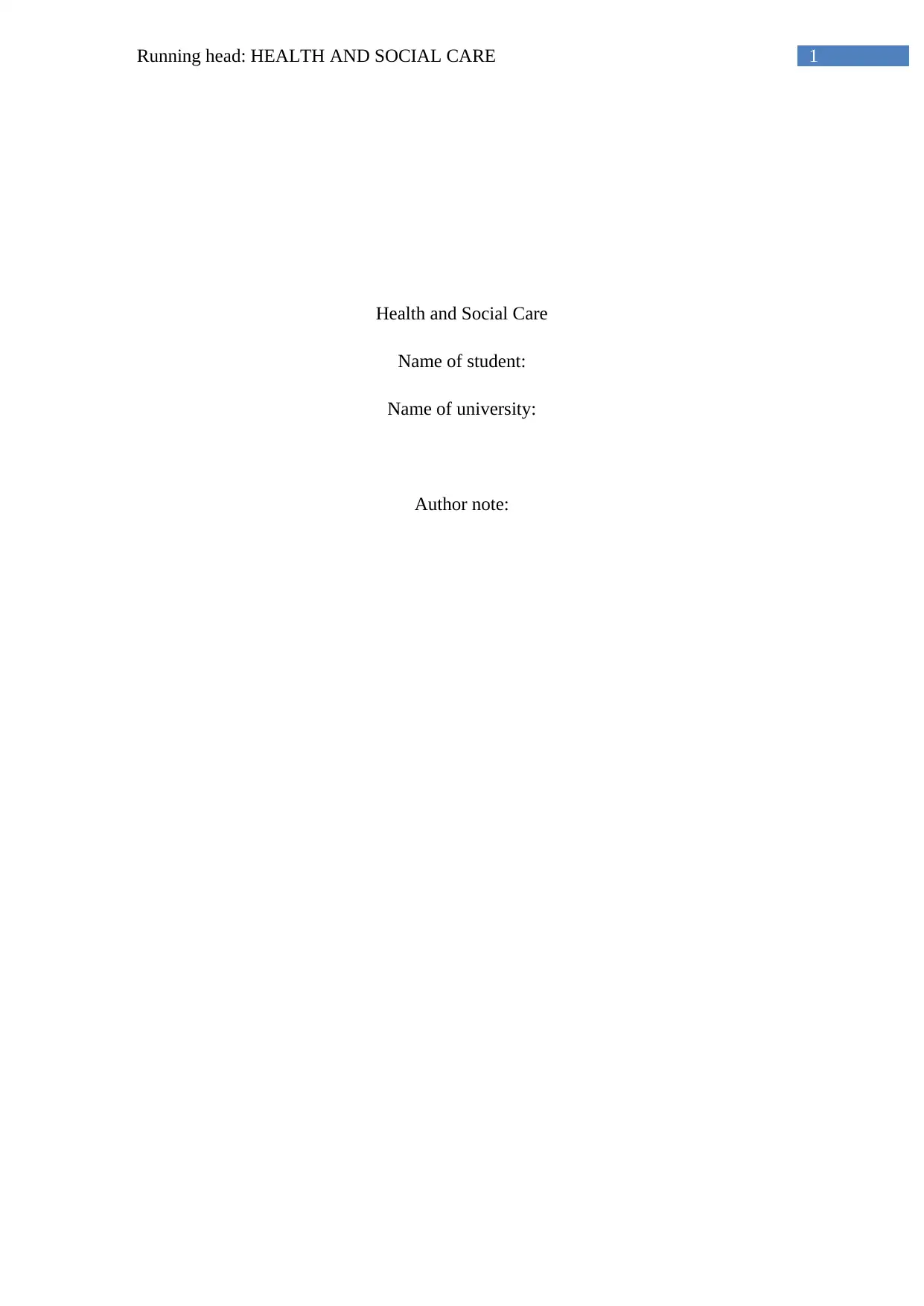
1Running head: HEALTH AND SOCIAL CARE
Health and Social Care
Name of student:
Name of university:
Author note:
Health and Social Care
Name of student:
Name of university:
Author note:
Paraphrase This Document
Need a fresh take? Get an instant paraphrase of this document with our AI Paraphraser
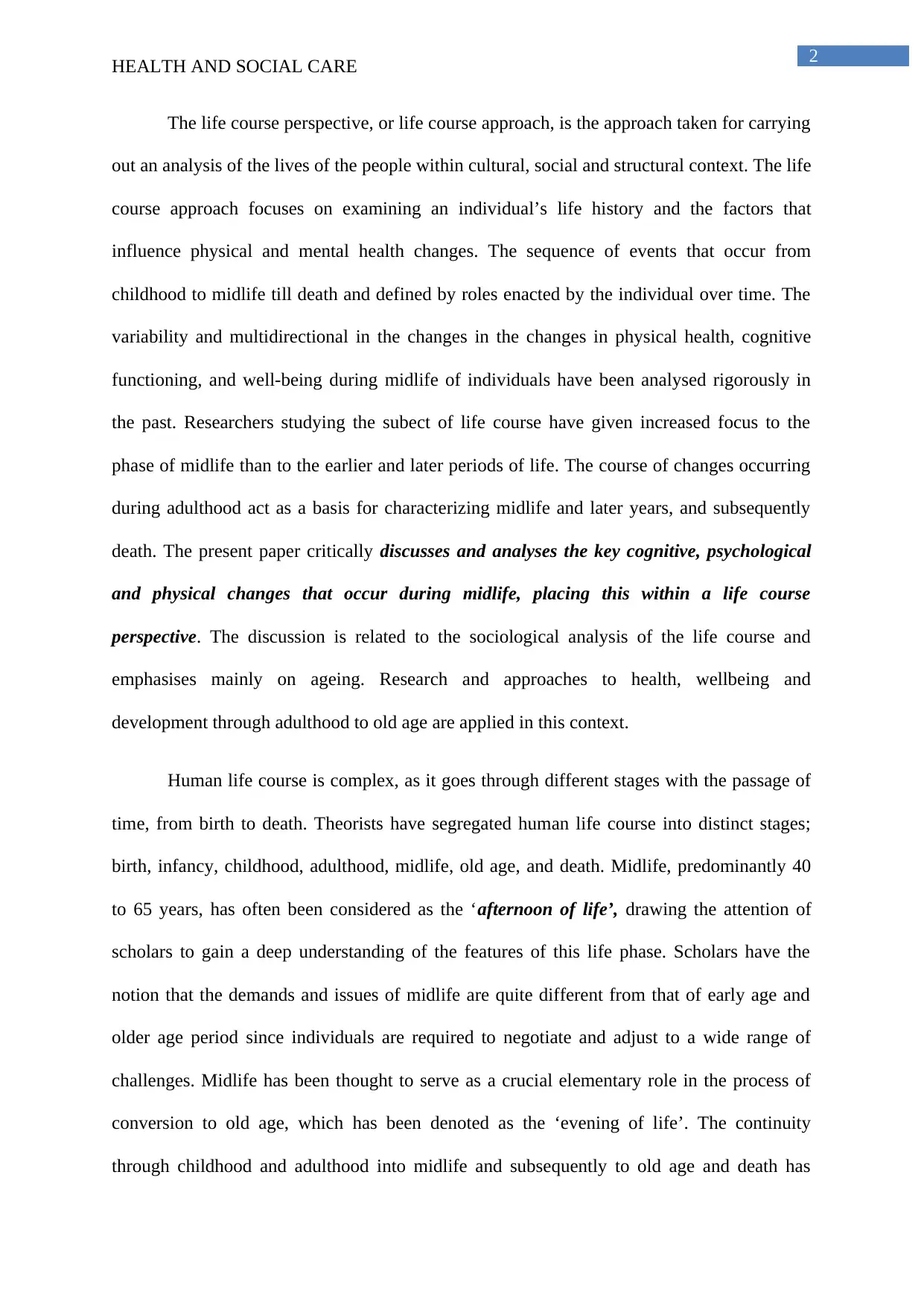
2
HEALTH AND SOCIAL CARE
The life course perspective, or life course approach, is the approach taken for carrying
out an analysis of the lives of the people within cultural, social and structural context. The life
course approach focuses on examining an individual’s life history and the factors that
influence physical and mental health changes. The sequence of events that occur from
childhood to midlife till death and defined by roles enacted by the individual over time. The
variability and multidirectional in the changes in the changes in physical health, cognitive
functioning, and well-being during midlife of individuals have been analysed rigorously in
the past. Researchers studying the subect of life course have given increased focus to the
phase of midlife than to the earlier and later periods of life. The course of changes occurring
during adulthood act as a basis for characterizing midlife and later years, and subsequently
death. The present paper critically discusses and analyses the key cognitive, psychological
and physical changes that occur during midlife, placing this within a life course
perspective. The discussion is related to the sociological analysis of the life course and
emphasises mainly on ageing. Research and approaches to health, wellbeing and
development through adulthood to old age are applied in this context.
Human life course is complex, as it goes through different stages with the passage of
time, from birth to death. Theorists have segregated human life course into distinct stages;
birth, infancy, childhood, adulthood, midlife, old age, and death. Midlife, predominantly 40
to 65 years, has often been considered as the ‘afternoon of life’, drawing the attention of
scholars to gain a deep understanding of the features of this life phase. Scholars have the
notion that the demands and issues of midlife are quite different from that of early age and
older age period since individuals are required to negotiate and adjust to a wide range of
challenges. Midlife has been thought to serve as a crucial elementary role in the process of
conversion to old age, which has been denoted as the ‘evening of life’. The continuity
through childhood and adulthood into midlife and subsequently to old age and death has
HEALTH AND SOCIAL CARE
The life course perspective, or life course approach, is the approach taken for carrying
out an analysis of the lives of the people within cultural, social and structural context. The life
course approach focuses on examining an individual’s life history and the factors that
influence physical and mental health changes. The sequence of events that occur from
childhood to midlife till death and defined by roles enacted by the individual over time. The
variability and multidirectional in the changes in the changes in physical health, cognitive
functioning, and well-being during midlife of individuals have been analysed rigorously in
the past. Researchers studying the subect of life course have given increased focus to the
phase of midlife than to the earlier and later periods of life. The course of changes occurring
during adulthood act as a basis for characterizing midlife and later years, and subsequently
death. The present paper critically discusses and analyses the key cognitive, psychological
and physical changes that occur during midlife, placing this within a life course
perspective. The discussion is related to the sociological analysis of the life course and
emphasises mainly on ageing. Research and approaches to health, wellbeing and
development through adulthood to old age are applied in this context.
Human life course is complex, as it goes through different stages with the passage of
time, from birth to death. Theorists have segregated human life course into distinct stages;
birth, infancy, childhood, adulthood, midlife, old age, and death. Midlife, predominantly 40
to 65 years, has often been considered as the ‘afternoon of life’, drawing the attention of
scholars to gain a deep understanding of the features of this life phase. Scholars have the
notion that the demands and issues of midlife are quite different from that of early age and
older age period since individuals are required to negotiate and adjust to a wide range of
challenges. Midlife has been thought to serve as a crucial elementary role in the process of
conversion to old age, which has been denoted as the ‘evening of life’. The continuity
through childhood and adulthood into midlife and subsequently to old age and death has
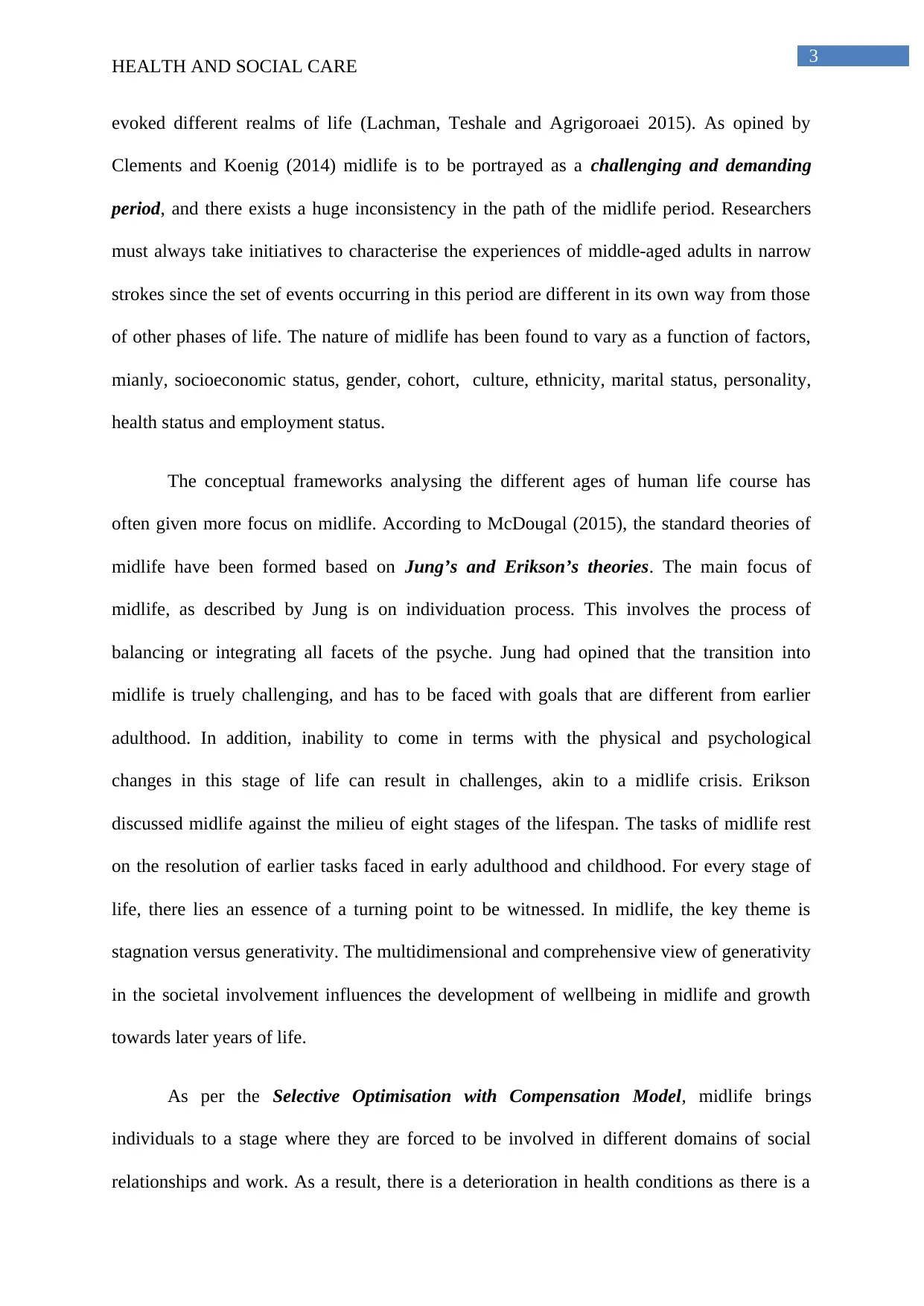
3
HEALTH AND SOCIAL CARE
evoked different realms of life (Lachman, Teshale and Agrigoroaei 2015). As opined by
Clements and Koenig (2014) midlife is to be portrayed as a challenging and demanding
period, and there exists a huge inconsistency in the path of the midlife period. Researchers
must always take initiatives to characterise the experiences of middle-aged adults in narrow
strokes since the set of events occurring in this period are different in its own way from those
of other phases of life. The nature of midlife has been found to vary as a function of factors,
mianly, socioeconomic status, gender, cohort, culture, ethnicity, marital status, personality,
health status and employment status.
The conceptual frameworks analysing the different ages of human life course has
often given more focus on midlife. According to McDougal (2015), the standard theories of
midlife have been formed based on Jung’s and Erikson’s theories. The main focus of
midlife, as described by Jung is on individuation process. This involves the process of
balancing or integrating all facets of the psyche. Jung had opined that the transition into
midlife is truely challenging, and has to be faced with goals that are different from earlier
adulthood. In addition, inability to come in terms with the physical and psychological
changes in this stage of life can result in challenges, akin to a midlife crisis. Erikson
discussed midlife against the milieu of eight stages of the lifespan. The tasks of midlife rest
on the resolution of earlier tasks faced in early adulthood and childhood. For every stage of
life, there lies an essence of a turning point to be witnessed. In midlife, the key theme is
stagnation versus generativity. The multidimensional and comprehensive view of generativity
in the societal involvement influences the development of wellbeing in midlife and growth
towards later years of life.
As per the Selective Optimisation with Compensation Model, midlife brings
individuals to a stage where they are forced to be involved in different domains of social
relationships and work. As a result, there is a deterioration in health conditions as there is a
HEALTH AND SOCIAL CARE
evoked different realms of life (Lachman, Teshale and Agrigoroaei 2015). As opined by
Clements and Koenig (2014) midlife is to be portrayed as a challenging and demanding
period, and there exists a huge inconsistency in the path of the midlife period. Researchers
must always take initiatives to characterise the experiences of middle-aged adults in narrow
strokes since the set of events occurring in this period are different in its own way from those
of other phases of life. The nature of midlife has been found to vary as a function of factors,
mianly, socioeconomic status, gender, cohort, culture, ethnicity, marital status, personality,
health status and employment status.
The conceptual frameworks analysing the different ages of human life course has
often given more focus on midlife. According to McDougal (2015), the standard theories of
midlife have been formed based on Jung’s and Erikson’s theories. The main focus of
midlife, as described by Jung is on individuation process. This involves the process of
balancing or integrating all facets of the psyche. Jung had opined that the transition into
midlife is truely challenging, and has to be faced with goals that are different from earlier
adulthood. In addition, inability to come in terms with the physical and psychological
changes in this stage of life can result in challenges, akin to a midlife crisis. Erikson
discussed midlife against the milieu of eight stages of the lifespan. The tasks of midlife rest
on the resolution of earlier tasks faced in early adulthood and childhood. For every stage of
life, there lies an essence of a turning point to be witnessed. In midlife, the key theme is
stagnation versus generativity. The multidimensional and comprehensive view of generativity
in the societal involvement influences the development of wellbeing in midlife and growth
towards later years of life.
As per the Selective Optimisation with Compensation Model, midlife brings
individuals to a stage where they are forced to be involved in different domains of social
relationships and work. As a result, there is a deterioration in health conditions as there is a
⊘ This is a preview!⊘
Do you want full access?
Subscribe today to unlock all pages.

Trusted by 1+ million students worldwide
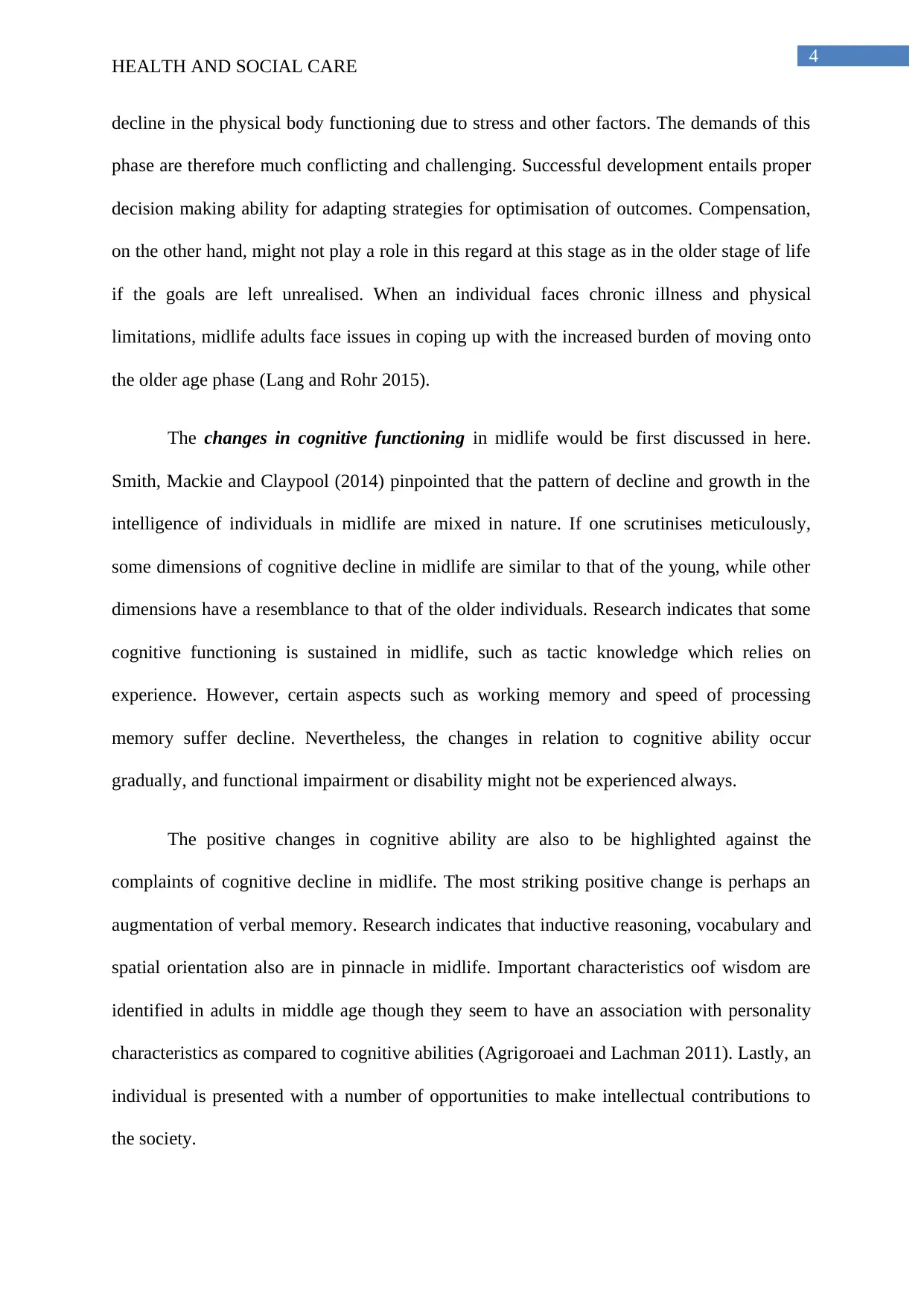
4
HEALTH AND SOCIAL CARE
decline in the physical body functioning due to stress and other factors. The demands of this
phase are therefore much conflicting and challenging. Successful development entails proper
decision making ability for adapting strategies for optimisation of outcomes. Compensation,
on the other hand, might not play a role in this regard at this stage as in the older stage of life
if the goals are left unrealised. When an individual faces chronic illness and physical
limitations, midlife adults face issues in coping up with the increased burden of moving onto
the older age phase (Lang and Rohr 2015).
The changes in cognitive functioning in midlife would be first discussed in here.
Smith, Mackie and Claypool (2014) pinpointed that the pattern of decline and growth in the
intelligence of individuals in midlife are mixed in nature. If one scrutinises meticulously,
some dimensions of cognitive decline in midlife are similar to that of the young, while other
dimensions have a resemblance to that of the older individuals. Research indicates that some
cognitive functioning is sustained in midlife, such as tactic knowledge which relies on
experience. However, certain aspects such as working memory and speed of processing
memory suffer decline. Nevertheless, the changes in relation to cognitive ability occur
gradually, and functional impairment or disability might not be experienced always.
The positive changes in cognitive ability are also to be highlighted against the
complaints of cognitive decline in midlife. The most striking positive change is perhaps an
augmentation of verbal memory. Research indicates that inductive reasoning, vocabulary and
spatial orientation also are in pinnacle in midlife. Important characteristics oof wisdom are
identified in adults in middle age though they seem to have an association with personality
characteristics as compared to cognitive abilities (Agrigoroaei and Lachman 2011). Lastly, an
individual is presented with a number of opportunities to make intellectual contributions to
the society.
HEALTH AND SOCIAL CARE
decline in the physical body functioning due to stress and other factors. The demands of this
phase are therefore much conflicting and challenging. Successful development entails proper
decision making ability for adapting strategies for optimisation of outcomes. Compensation,
on the other hand, might not play a role in this regard at this stage as in the older stage of life
if the goals are left unrealised. When an individual faces chronic illness and physical
limitations, midlife adults face issues in coping up with the increased burden of moving onto
the older age phase (Lang and Rohr 2015).
The changes in cognitive functioning in midlife would be first discussed in here.
Smith, Mackie and Claypool (2014) pinpointed that the pattern of decline and growth in the
intelligence of individuals in midlife are mixed in nature. If one scrutinises meticulously,
some dimensions of cognitive decline in midlife are similar to that of the young, while other
dimensions have a resemblance to that of the older individuals. Research indicates that some
cognitive functioning is sustained in midlife, such as tactic knowledge which relies on
experience. However, certain aspects such as working memory and speed of processing
memory suffer decline. Nevertheless, the changes in relation to cognitive ability occur
gradually, and functional impairment or disability might not be experienced always.
The positive changes in cognitive ability are also to be highlighted against the
complaints of cognitive decline in midlife. The most striking positive change is perhaps an
augmentation of verbal memory. Research indicates that inductive reasoning, vocabulary and
spatial orientation also are in pinnacle in midlife. Important characteristics oof wisdom are
identified in adults in middle age though they seem to have an association with personality
characteristics as compared to cognitive abilities (Agrigoroaei and Lachman 2011). Lastly, an
individual is presented with a number of opportunities to make intellectual contributions to
the society.
Paraphrase This Document
Need a fresh take? Get an instant paraphrase of this document with our AI Paraphraser
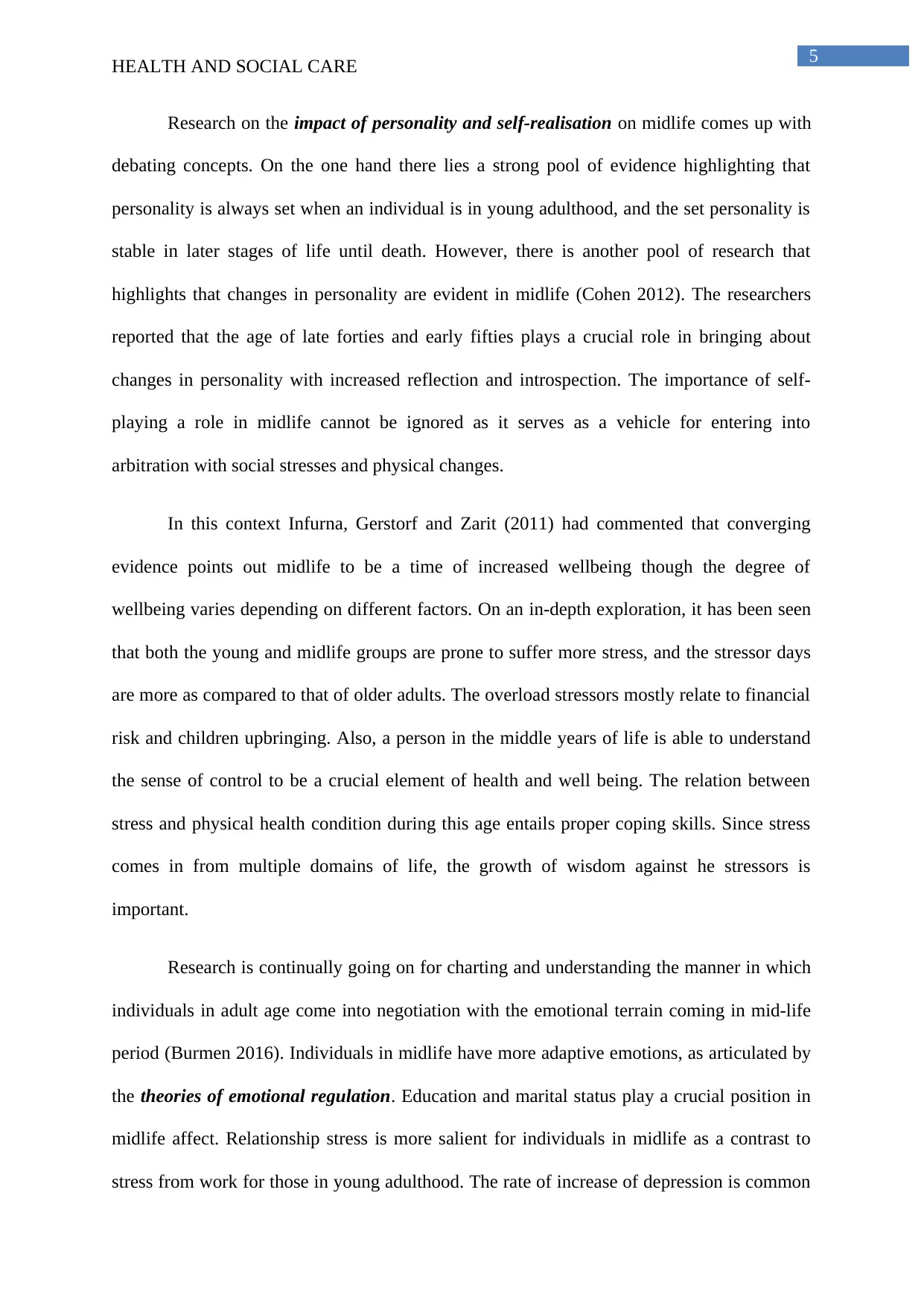
5
HEALTH AND SOCIAL CARE
Research on the impact of personality and self-realisation on midlife comes up with
debating concepts. On the one hand there lies a strong pool of evidence highlighting that
personality is always set when an individual is in young adulthood, and the set personality is
stable in later stages of life until death. However, there is another pool of research that
highlights that changes in personality are evident in midlife (Cohen 2012). The researchers
reported that the age of late forties and early fifties plays a crucial role in bringing about
changes in personality with increased reflection and introspection. The importance of self-
playing a role in midlife cannot be ignored as it serves as a vehicle for entering into
arbitration with social stresses and physical changes.
In this context Infurna, Gerstorf and Zarit (2011) had commented that converging
evidence points out midlife to be a time of increased wellbeing though the degree of
wellbeing varies depending on different factors. On an in-depth exploration, it has been seen
that both the young and midlife groups are prone to suffer more stress, and the stressor days
are more as compared to that of older adults. The overload stressors mostly relate to financial
risk and children upbringing. Also, a person in the middle years of life is able to understand
the sense of control to be a crucial element of health and well being. The relation between
stress and physical health condition during this age entails proper coping skills. Since stress
comes in from multiple domains of life, the growth of wisdom against he stressors is
important.
Research is continually going on for charting and understanding the manner in which
individuals in adult age come into negotiation with the emotional terrain coming in mid-life
period (Burmen 2016). Individuals in midlife have more adaptive emotions, as articulated by
the theories of emotional regulation. Education and marital status play a crucial position in
midlife affect. Relationship stress is more salient for individuals in midlife as a contrast to
stress from work for those in young adulthood. The rate of increase of depression is common
HEALTH AND SOCIAL CARE
Research on the impact of personality and self-realisation on midlife comes up with
debating concepts. On the one hand there lies a strong pool of evidence highlighting that
personality is always set when an individual is in young adulthood, and the set personality is
stable in later stages of life until death. However, there is another pool of research that
highlights that changes in personality are evident in midlife (Cohen 2012). The researchers
reported that the age of late forties and early fifties plays a crucial role in bringing about
changes in personality with increased reflection and introspection. The importance of self-
playing a role in midlife cannot be ignored as it serves as a vehicle for entering into
arbitration with social stresses and physical changes.
In this context Infurna, Gerstorf and Zarit (2011) had commented that converging
evidence points out midlife to be a time of increased wellbeing though the degree of
wellbeing varies depending on different factors. On an in-depth exploration, it has been seen
that both the young and midlife groups are prone to suffer more stress, and the stressor days
are more as compared to that of older adults. The overload stressors mostly relate to financial
risk and children upbringing. Also, a person in the middle years of life is able to understand
the sense of control to be a crucial element of health and well being. The relation between
stress and physical health condition during this age entails proper coping skills. Since stress
comes in from multiple domains of life, the growth of wisdom against he stressors is
important.
Research is continually going on for charting and understanding the manner in which
individuals in adult age come into negotiation with the emotional terrain coming in mid-life
period (Burmen 2016). Individuals in midlife have more adaptive emotions, as articulated by
the theories of emotional regulation. Education and marital status play a crucial position in
midlife affect. Relationship stress is more salient for individuals in midlife as a contrast to
stress from work for those in young adulthood. The rate of increase of depression is common
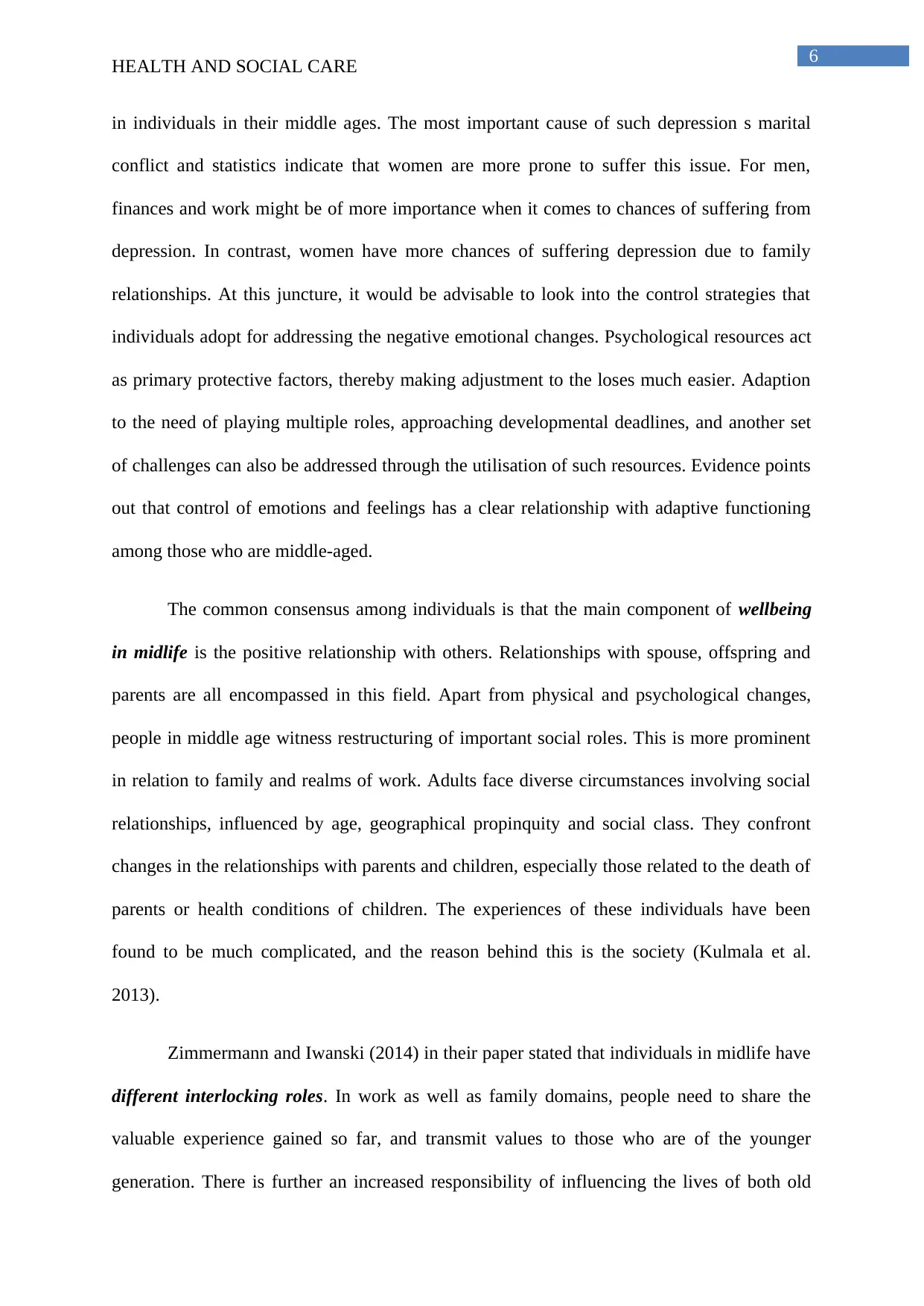
6
HEALTH AND SOCIAL CARE
in individuals in their middle ages. The most important cause of such depression s marital
conflict and statistics indicate that women are more prone to suffer this issue. For men,
finances and work might be of more importance when it comes to chances of suffering from
depression. In contrast, women have more chances of suffering depression due to family
relationships. At this juncture, it would be advisable to look into the control strategies that
individuals adopt for addressing the negative emotional changes. Psychological resources act
as primary protective factors, thereby making adjustment to the loses much easier. Adaption
to the need of playing multiple roles, approaching developmental deadlines, and another set
of challenges can also be addressed through the utilisation of such resources. Evidence points
out that control of emotions and feelings has a clear relationship with adaptive functioning
among those who are middle-aged.
The common consensus among individuals is that the main component of wellbeing
in midlife is the positive relationship with others. Relationships with spouse, offspring and
parents are all encompassed in this field. Apart from physical and psychological changes,
people in middle age witness restructuring of important social roles. This is more prominent
in relation to family and realms of work. Adults face diverse circumstances involving social
relationships, influenced by age, geographical propinquity and social class. They confront
changes in the relationships with parents and children, especially those related to the death of
parents or health conditions of children. The experiences of these individuals have been
found to be much complicated, and the reason behind this is the society (Kulmala et al.
2013).
Zimmermann and Iwanski (2014) in their paper stated that individuals in midlife have
different interlocking roles. In work as well as family domains, people need to share the
valuable experience gained so far, and transmit values to those who are of the younger
generation. There is further an increased responsibility of influencing the lives of both old
HEALTH AND SOCIAL CARE
in individuals in their middle ages. The most important cause of such depression s marital
conflict and statistics indicate that women are more prone to suffer this issue. For men,
finances and work might be of more importance when it comes to chances of suffering from
depression. In contrast, women have more chances of suffering depression due to family
relationships. At this juncture, it would be advisable to look into the control strategies that
individuals adopt for addressing the negative emotional changes. Psychological resources act
as primary protective factors, thereby making adjustment to the loses much easier. Adaption
to the need of playing multiple roles, approaching developmental deadlines, and another set
of challenges can also be addressed through the utilisation of such resources. Evidence points
out that control of emotions and feelings has a clear relationship with adaptive functioning
among those who are middle-aged.
The common consensus among individuals is that the main component of wellbeing
in midlife is the positive relationship with others. Relationships with spouse, offspring and
parents are all encompassed in this field. Apart from physical and psychological changes,
people in middle age witness restructuring of important social roles. This is more prominent
in relation to family and realms of work. Adults face diverse circumstances involving social
relationships, influenced by age, geographical propinquity and social class. They confront
changes in the relationships with parents and children, especially those related to the death of
parents or health conditions of children. The experiences of these individuals have been
found to be much complicated, and the reason behind this is the society (Kulmala et al.
2013).
Zimmermann and Iwanski (2014) in their paper stated that individuals in midlife have
different interlocking roles. In work as well as family domains, people need to share the
valuable experience gained so far, and transmit values to those who are of the younger
generation. There is further an increased responsibility of influencing the lives of both old
⊘ This is a preview!⊘
Do you want full access?
Subscribe today to unlock all pages.

Trusted by 1+ million students worldwide
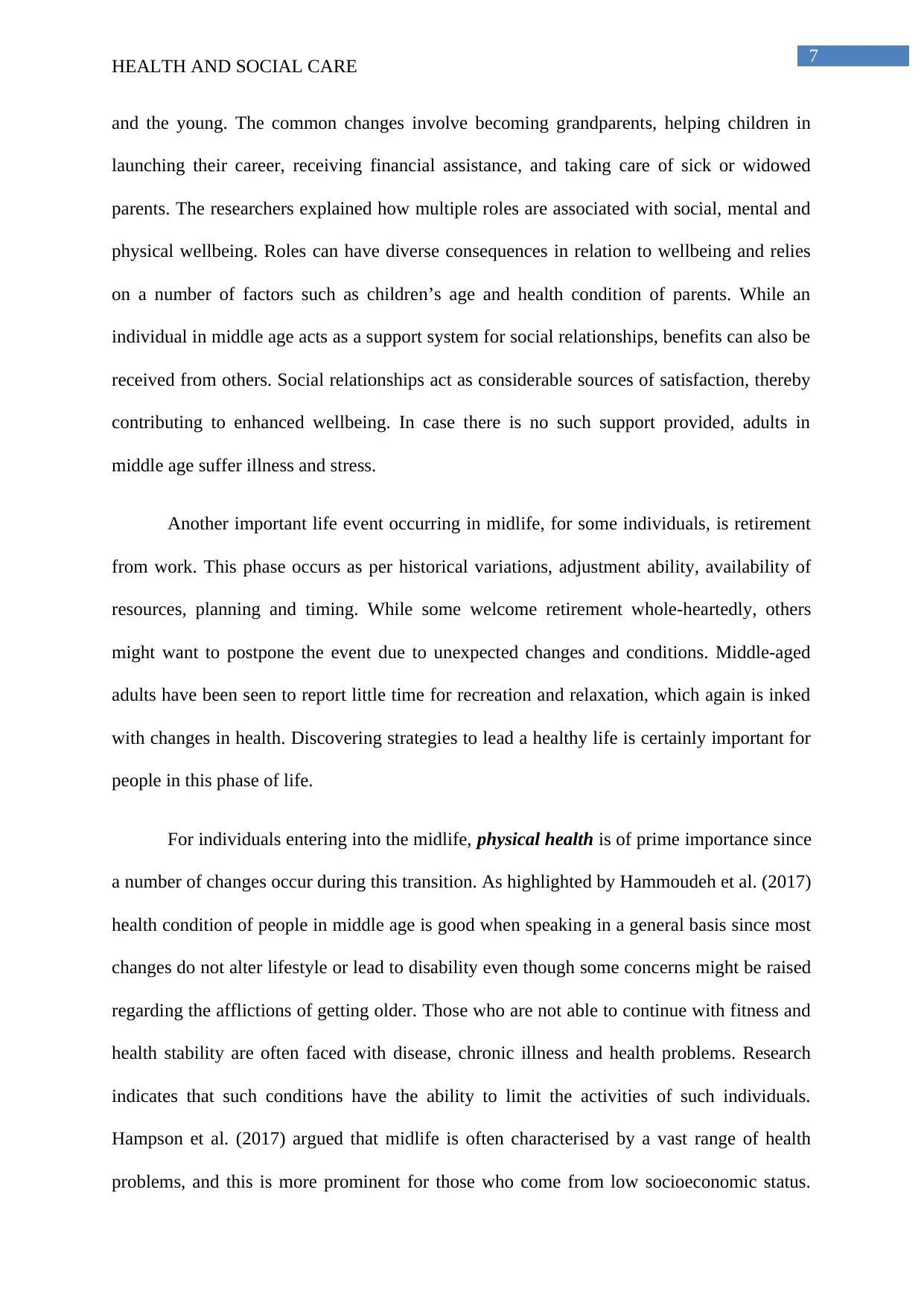
7
HEALTH AND SOCIAL CARE
and the young. The common changes involve becoming grandparents, helping children in
launching their career, receiving financial assistance, and taking care of sick or widowed
parents. The researchers explained how multiple roles are associated with social, mental and
physical wellbeing. Roles can have diverse consequences in relation to wellbeing and relies
on a number of factors such as children’s age and health condition of parents. While an
individual in middle age acts as a support system for social relationships, benefits can also be
received from others. Social relationships act as considerable sources of satisfaction, thereby
contributing to enhanced wellbeing. In case there is no such support provided, adults in
middle age suffer illness and stress.
Another important life event occurring in midlife, for some individuals, is retirement
from work. This phase occurs as per historical variations, adjustment ability, availability of
resources, planning and timing. While some welcome retirement whole-heartedly, others
might want to postpone the event due to unexpected changes and conditions. Middle-aged
adults have been seen to report little time for recreation and relaxation, which again is inked
with changes in health. Discovering strategies to lead a healthy life is certainly important for
people in this phase of life.
For individuals entering into the midlife, physical health is of prime importance since
a number of changes occur during this transition. As highlighted by Hammoudeh et al. (2017)
health condition of people in middle age is good when speaking in a general basis since most
changes do not alter lifestyle or lead to disability even though some concerns might be raised
regarding the afflictions of getting older. Those who are not able to continue with fitness and
health stability are often faced with disease, chronic illness and health problems. Research
indicates that such conditions have the ability to limit the activities of such individuals.
Hampson et al. (2017) argued that midlife is often characterised by a vast range of health
problems, and this is more prominent for those who come from low socioeconomic status.
HEALTH AND SOCIAL CARE
and the young. The common changes involve becoming grandparents, helping children in
launching their career, receiving financial assistance, and taking care of sick or widowed
parents. The researchers explained how multiple roles are associated with social, mental and
physical wellbeing. Roles can have diverse consequences in relation to wellbeing and relies
on a number of factors such as children’s age and health condition of parents. While an
individual in middle age acts as a support system for social relationships, benefits can also be
received from others. Social relationships act as considerable sources of satisfaction, thereby
contributing to enhanced wellbeing. In case there is no such support provided, adults in
middle age suffer illness and stress.
Another important life event occurring in midlife, for some individuals, is retirement
from work. This phase occurs as per historical variations, adjustment ability, availability of
resources, planning and timing. While some welcome retirement whole-heartedly, others
might want to postpone the event due to unexpected changes and conditions. Middle-aged
adults have been seen to report little time for recreation and relaxation, which again is inked
with changes in health. Discovering strategies to lead a healthy life is certainly important for
people in this phase of life.
For individuals entering into the midlife, physical health is of prime importance since
a number of changes occur during this transition. As highlighted by Hammoudeh et al. (2017)
health condition of people in middle age is good when speaking in a general basis since most
changes do not alter lifestyle or lead to disability even though some concerns might be raised
regarding the afflictions of getting older. Those who are not able to continue with fitness and
health stability are often faced with disease, chronic illness and health problems. Research
indicates that such conditions have the ability to limit the activities of such individuals.
Hampson et al. (2017) argued that midlife is often characterised by a vast range of health
problems, and this is more prominent for those who come from low socioeconomic status.
Paraphrase This Document
Need a fresh take? Get an instant paraphrase of this document with our AI Paraphraser
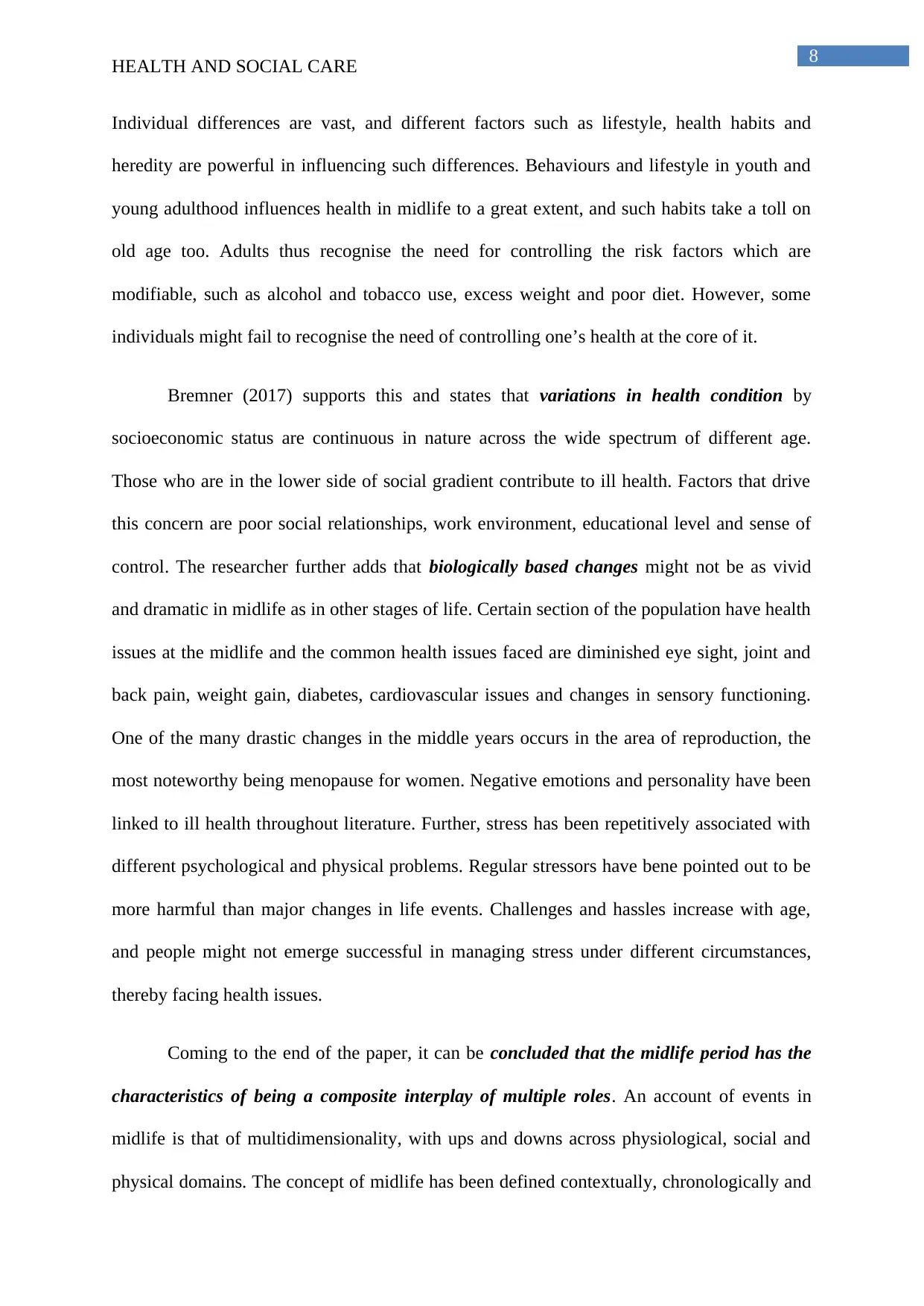
8
HEALTH AND SOCIAL CARE
Individual differences are vast, and different factors such as lifestyle, health habits and
heredity are powerful in influencing such differences. Behaviours and lifestyle in youth and
young adulthood influences health in midlife to a great extent, and such habits take a toll on
old age too. Adults thus recognise the need for controlling the risk factors which are
modifiable, such as alcohol and tobacco use, excess weight and poor diet. However, some
individuals might fail to recognise the need of controlling one’s health at the core of it.
Bremner (2017) supports this and states that variations in health condition by
socioeconomic status are continuous in nature across the wide spectrum of different age.
Those who are in the lower side of social gradient contribute to ill health. Factors that drive
this concern are poor social relationships, work environment, educational level and sense of
control. The researcher further adds that biologically based changes might not be as vivid
and dramatic in midlife as in other stages of life. Certain section of the population have health
issues at the midlife and the common health issues faced are diminished eye sight, joint and
back pain, weight gain, diabetes, cardiovascular issues and changes in sensory functioning.
One of the many drastic changes in the middle years occurs in the area of reproduction, the
most noteworthy being menopause for women. Negative emotions and personality have been
linked to ill health throughout literature. Further, stress has been repetitively associated with
different psychological and physical problems. Regular stressors have bene pointed out to be
more harmful than major changes in life events. Challenges and hassles increase with age,
and people might not emerge successful in managing stress under different circumstances,
thereby facing health issues.
Coming to the end of the paper, it can be concluded that the midlife period has the
characteristics of being a composite interplay of multiple roles. An account of events in
midlife is that of multidimensionality, with ups and downs across physiological, social and
physical domains. The concept of midlife has been defined contextually, chronologically and
HEALTH AND SOCIAL CARE
Individual differences are vast, and different factors such as lifestyle, health habits and
heredity are powerful in influencing such differences. Behaviours and lifestyle in youth and
young adulthood influences health in midlife to a great extent, and such habits take a toll on
old age too. Adults thus recognise the need for controlling the risk factors which are
modifiable, such as alcohol and tobacco use, excess weight and poor diet. However, some
individuals might fail to recognise the need of controlling one’s health at the core of it.
Bremner (2017) supports this and states that variations in health condition by
socioeconomic status are continuous in nature across the wide spectrum of different age.
Those who are in the lower side of social gradient contribute to ill health. Factors that drive
this concern are poor social relationships, work environment, educational level and sense of
control. The researcher further adds that biologically based changes might not be as vivid
and dramatic in midlife as in other stages of life. Certain section of the population have health
issues at the midlife and the common health issues faced are diminished eye sight, joint and
back pain, weight gain, diabetes, cardiovascular issues and changes in sensory functioning.
One of the many drastic changes in the middle years occurs in the area of reproduction, the
most noteworthy being menopause for women. Negative emotions and personality have been
linked to ill health throughout literature. Further, stress has been repetitively associated with
different psychological and physical problems. Regular stressors have bene pointed out to be
more harmful than major changes in life events. Challenges and hassles increase with age,
and people might not emerge successful in managing stress under different circumstances,
thereby facing health issues.
Coming to the end of the paper, it can be concluded that the midlife period has the
characteristics of being a composite interplay of multiple roles. An account of events in
midlife is that of multidimensionality, with ups and downs across physiological, social and
physical domains. The concept of midlife has been defined contextually, chronologically and
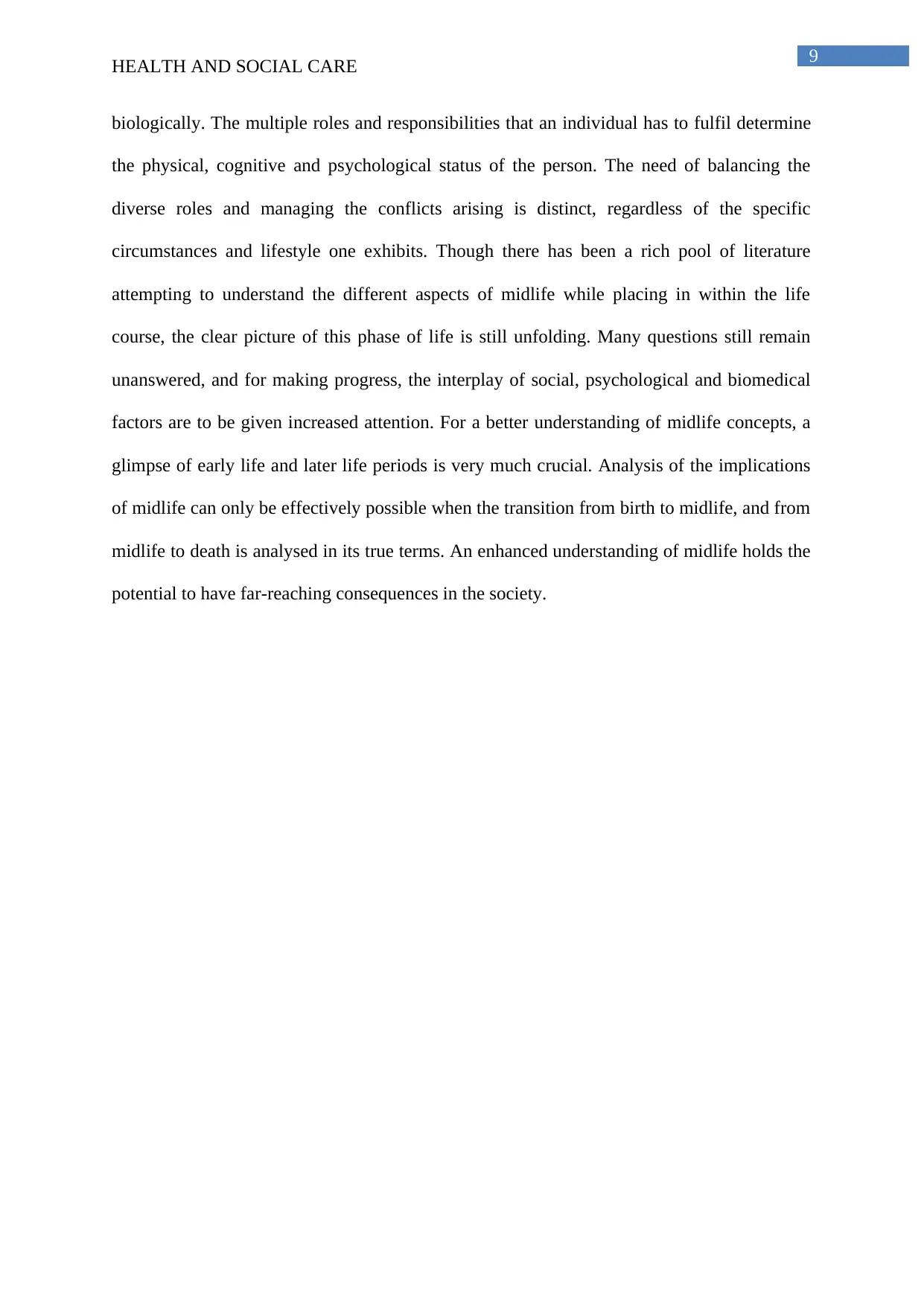
9
HEALTH AND SOCIAL CARE
biologically. The multiple roles and responsibilities that an individual has to fulfil determine
the physical, cognitive and psychological status of the person. The need of balancing the
diverse roles and managing the conflicts arising is distinct, regardless of the specific
circumstances and lifestyle one exhibits. Though there has been a rich pool of literature
attempting to understand the different aspects of midlife while placing in within the life
course, the clear picture of this phase of life is still unfolding. Many questions still remain
unanswered, and for making progress, the interplay of social, psychological and biomedical
factors are to be given increased attention. For a better understanding of midlife concepts, a
glimpse of early life and later life periods is very much crucial. Analysis of the implications
of midlife can only be effectively possible when the transition from birth to midlife, and from
midlife to death is analysed in its true terms. An enhanced understanding of midlife holds the
potential to have far-reaching consequences in the society.
HEALTH AND SOCIAL CARE
biologically. The multiple roles and responsibilities that an individual has to fulfil determine
the physical, cognitive and psychological status of the person. The need of balancing the
diverse roles and managing the conflicts arising is distinct, regardless of the specific
circumstances and lifestyle one exhibits. Though there has been a rich pool of literature
attempting to understand the different aspects of midlife while placing in within the life
course, the clear picture of this phase of life is still unfolding. Many questions still remain
unanswered, and for making progress, the interplay of social, psychological and biomedical
factors are to be given increased attention. For a better understanding of midlife concepts, a
glimpse of early life and later life periods is very much crucial. Analysis of the implications
of midlife can only be effectively possible when the transition from birth to midlife, and from
midlife to death is analysed in its true terms. An enhanced understanding of midlife holds the
potential to have far-reaching consequences in the society.
⊘ This is a preview!⊘
Do you want full access?
Subscribe today to unlock all pages.

Trusted by 1+ million students worldwide
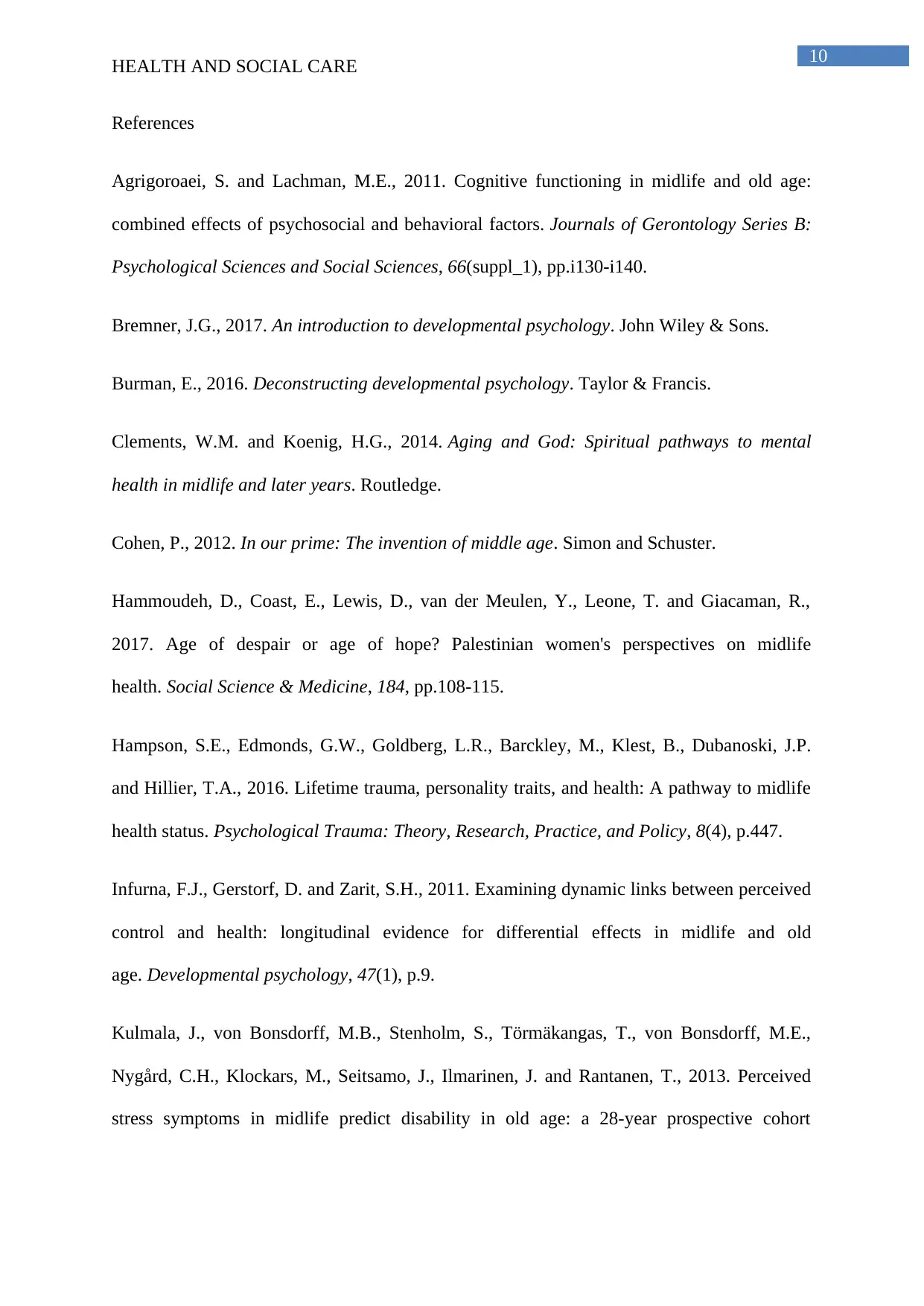
10
HEALTH AND SOCIAL CARE
References
Agrigoroaei, S. and Lachman, M.E., 2011. Cognitive functioning in midlife and old age:
combined effects of psychosocial and behavioral factors. Journals of Gerontology Series B:
Psychological Sciences and Social Sciences, 66(suppl_1), pp.i130-i140.
Bremner, J.G., 2017. An introduction to developmental psychology. John Wiley & Sons.
Burman, E., 2016. Deconstructing developmental psychology. Taylor & Francis.
Clements, W.M. and Koenig, H.G., 2014. Aging and God: Spiritual pathways to mental
health in midlife and later years. Routledge.
Cohen, P., 2012. In our prime: The invention of middle age. Simon and Schuster.
Hammoudeh, D., Coast, E., Lewis, D., van der Meulen, Y., Leone, T. and Giacaman, R.,
2017. Age of despair or age of hope? Palestinian women's perspectives on midlife
health. Social Science & Medicine, 184, pp.108-115.
Hampson, S.E., Edmonds, G.W., Goldberg, L.R., Barckley, M., Klest, B., Dubanoski, J.P.
and Hillier, T.A., 2016. Lifetime trauma, personality traits, and health: A pathway to midlife
health status. Psychological Trauma: Theory, Research, Practice, and Policy, 8(4), p.447.
Infurna, F.J., Gerstorf, D. and Zarit, S.H., 2011. Examining dynamic links between perceived
control and health: longitudinal evidence for differential effects in midlife and old
age. Developmental psychology, 47(1), p.9.
Kulmala, J., von Bonsdorff, M.B., Stenholm, S., Törmäkangas, T., von Bonsdorff, M.E.,
Nygård, C.H., Klockars, M., Seitsamo, J., Ilmarinen, J. and Rantanen, T., 2013. Perceived
stress symptoms in midlife predict disability in old age: a 28-year prospective cohort
HEALTH AND SOCIAL CARE
References
Agrigoroaei, S. and Lachman, M.E., 2011. Cognitive functioning in midlife and old age:
combined effects of psychosocial and behavioral factors. Journals of Gerontology Series B:
Psychological Sciences and Social Sciences, 66(suppl_1), pp.i130-i140.
Bremner, J.G., 2017. An introduction to developmental psychology. John Wiley & Sons.
Burman, E., 2016. Deconstructing developmental psychology. Taylor & Francis.
Clements, W.M. and Koenig, H.G., 2014. Aging and God: Spiritual pathways to mental
health in midlife and later years. Routledge.
Cohen, P., 2012. In our prime: The invention of middle age. Simon and Schuster.
Hammoudeh, D., Coast, E., Lewis, D., van der Meulen, Y., Leone, T. and Giacaman, R.,
2017. Age of despair or age of hope? Palestinian women's perspectives on midlife
health. Social Science & Medicine, 184, pp.108-115.
Hampson, S.E., Edmonds, G.W., Goldberg, L.R., Barckley, M., Klest, B., Dubanoski, J.P.
and Hillier, T.A., 2016. Lifetime trauma, personality traits, and health: A pathway to midlife
health status. Psychological Trauma: Theory, Research, Practice, and Policy, 8(4), p.447.
Infurna, F.J., Gerstorf, D. and Zarit, S.H., 2011. Examining dynamic links between perceived
control and health: longitudinal evidence for differential effects in midlife and old
age. Developmental psychology, 47(1), p.9.
Kulmala, J., von Bonsdorff, M.B., Stenholm, S., Törmäkangas, T., von Bonsdorff, M.E.,
Nygård, C.H., Klockars, M., Seitsamo, J., Ilmarinen, J. and Rantanen, T., 2013. Perceived
stress symptoms in midlife predict disability in old age: a 28-year prospective cohort
Paraphrase This Document
Need a fresh take? Get an instant paraphrase of this document with our AI Paraphraser
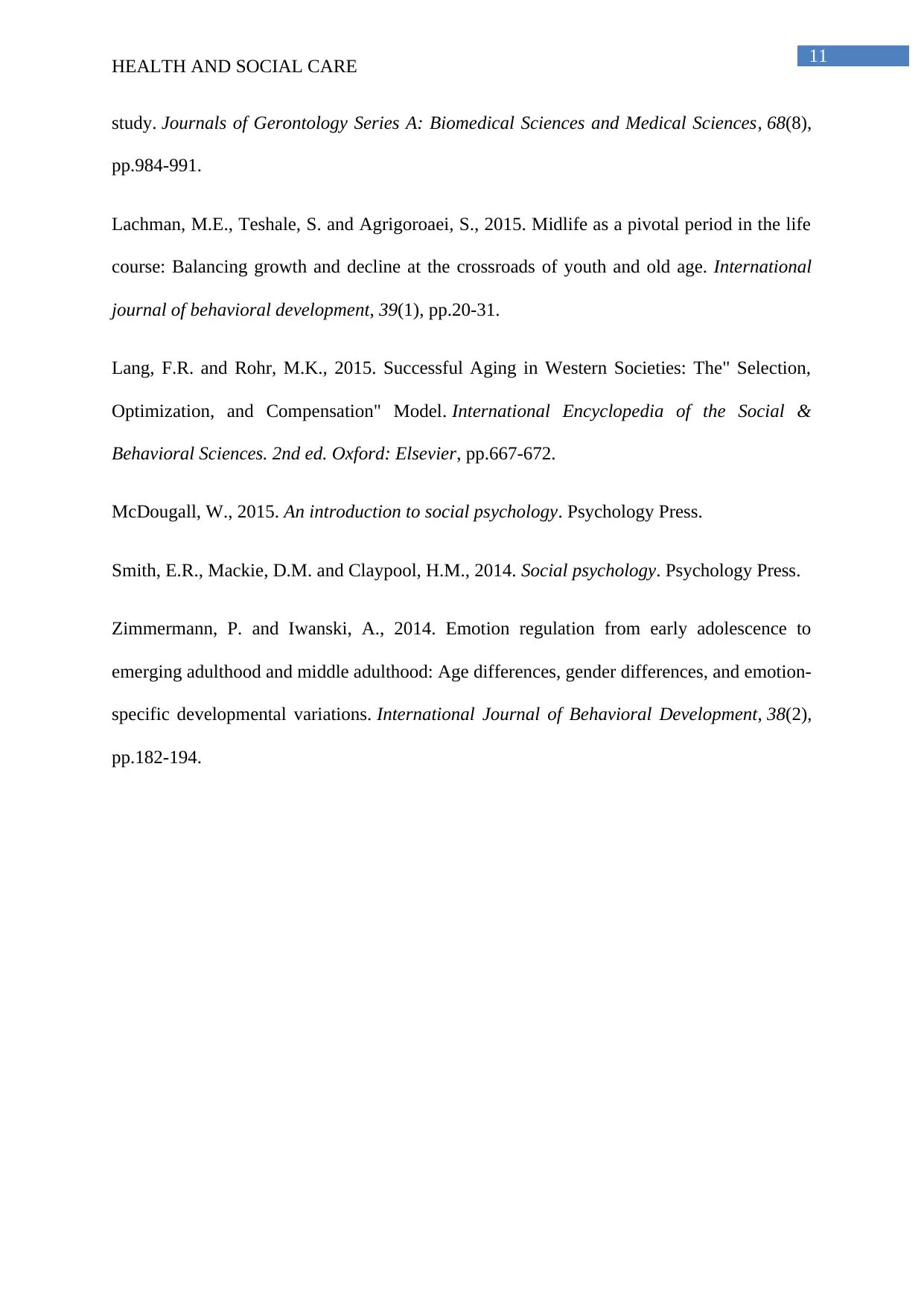
11
HEALTH AND SOCIAL CARE
study. Journals of Gerontology Series A: Biomedical Sciences and Medical Sciences, 68(8),
pp.984-991.
Lachman, M.E., Teshale, S. and Agrigoroaei, S., 2015. Midlife as a pivotal period in the life
course: Balancing growth and decline at the crossroads of youth and old age. International
journal of behavioral development, 39(1), pp.20-31.
Lang, F.R. and Rohr, M.K., 2015. Successful Aging in Western Societies: The" Selection,
Optimization, and Compensation" Model. International Encyclopedia of the Social &
Behavioral Sciences. 2nd ed. Oxford: Elsevier, pp.667-672.
McDougall, W., 2015. An introduction to social psychology. Psychology Press.
Smith, E.R., Mackie, D.M. and Claypool, H.M., 2014. Social psychology. Psychology Press.
Zimmermann, P. and Iwanski, A., 2014. Emotion regulation from early adolescence to
emerging adulthood and middle adulthood: Age differences, gender differences, and emotion-
specific developmental variations. International Journal of Behavioral Development, 38(2),
pp.182-194.
HEALTH AND SOCIAL CARE
study. Journals of Gerontology Series A: Biomedical Sciences and Medical Sciences, 68(8),
pp.984-991.
Lachman, M.E., Teshale, S. and Agrigoroaei, S., 2015. Midlife as a pivotal period in the life
course: Balancing growth and decline at the crossroads of youth and old age. International
journal of behavioral development, 39(1), pp.20-31.
Lang, F.R. and Rohr, M.K., 2015. Successful Aging in Western Societies: The" Selection,
Optimization, and Compensation" Model. International Encyclopedia of the Social &
Behavioral Sciences. 2nd ed. Oxford: Elsevier, pp.667-672.
McDougall, W., 2015. An introduction to social psychology. Psychology Press.
Smith, E.R., Mackie, D.M. and Claypool, H.M., 2014. Social psychology. Psychology Press.
Zimmermann, P. and Iwanski, A., 2014. Emotion regulation from early adolescence to
emerging adulthood and middle adulthood: Age differences, gender differences, and emotion-
specific developmental variations. International Journal of Behavioral Development, 38(2),
pp.182-194.
1 out of 11
Related Documents
Your All-in-One AI-Powered Toolkit for Academic Success.
+13062052269
info@desklib.com
Available 24*7 on WhatsApp / Email
![[object Object]](/_next/static/media/star-bottom.7253800d.svg)
Unlock your academic potential
Copyright © 2020–2025 A2Z Services. All Rights Reserved. Developed and managed by ZUCOL.




